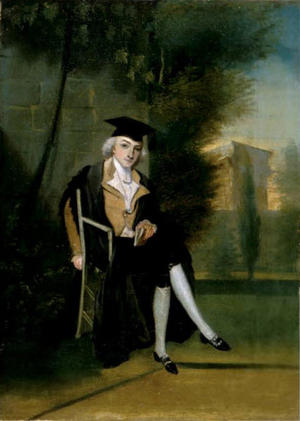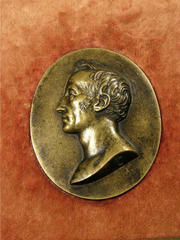 James Smithson (c.1765–1829), the founding donor of the Smithsonian was an English chemist and mineralogist. He was the illegitimate son of Hugh Smithson, the first Duke of Northumberland, and Elizabeth Hungerford Keate Macie, a wealthy widow who was a cousin of the Duchess of Northumberland. His exact birthday remains unknown because he was born in secret in Paris, where his mother had gone to hide her pregnancy. In his youth, his name was James Lewis Macie, but in 1801, after his parents died, he took his father’s last name of Smithson.
James Smithson (c.1765–1829), the founding donor of the Smithsonian was an English chemist and mineralogist. He was the illegitimate son of Hugh Smithson, the first Duke of Northumberland, and Elizabeth Hungerford Keate Macie, a wealthy widow who was a cousin of the Duchess of Northumberland. His exact birthday remains unknown because he was born in secret in Paris, where his mother had gone to hide her pregnancy. In his youth, his name was James Lewis Macie, but in 1801, after his parents died, he took his father’s last name of Smithson.
 Smithson never married; he had no children; and he lived a peripatetic life, traveling widely in Europe during a time of great turbulence and political upheaval. He was in Paris during the French Revolution, and was later imprisoned during the Napoleonic Wars. Friends with many of the great scientific minds of his age, he believed that the pursuit of science and knowledge was the key to happiness and prosperity for all of society. He saw scientists as benefactors of all mankind, and thought that they should be considered “citizens of the world.”
Smithson never married; he had no children; and he lived a peripatetic life, traveling widely in Europe during a time of great turbulence and political upheaval. He was in Paris during the French Revolution, and was later imprisoned during the Napoleonic Wars. Friends with many of the great scientific minds of his age, he believed that the pursuit of science and knowledge was the key to happiness and prosperity for all of society. He saw scientists as benefactors of all mankind, and thought that they should be considered “citizens of the world.”
 Smithson was interested in almost everything and studied a wide range of natural phenomena: the venom of snakes, the chemistry of volcanoes, the constituents of a lady’s tear, and even the fundamental nature of electricity. He published twenty-seven papers in his lifetime, ranging from an improved method of making coffee, to an analysis of the mineral calamine, critical in the manufacture of brass—which led to the mineral being named smithsonite in his honor. In one of his last papers, he laid out his philosophy most clearly: “It is in his knowledge that man has found his greatness and his happiness. . . . No ignorance is probably without loss to him.”
Smithson was interested in almost everything and studied a wide range of natural phenomena: the venom of snakes, the chemistry of volcanoes, the constituents of a lady’s tear, and even the fundamental nature of electricity. He published twenty-seven papers in his lifetime, ranging from an improved method of making coffee, to an analysis of the mineral calamine, critical in the manufacture of brass—which led to the mineral being named smithsonite in his honor. In one of his last papers, he laid out his philosophy most clearly: “It is in his knowledge that man has found his greatness and his happiness. . . . No ignorance is probably without loss to him.”

Further Exploration
Related Links
- The Lost World of James Smithson: Science, Revolution, and the Birth of the Smithsonian, by Heather Ewing.
- A Most Unusual Bequest, Smithsonian Mobile
- From Smithson to Smithsonian: The Birth of an Institution, Smithsonian Institution Libraries Online
- James Smithson, Founder of the Smithsonian
- Smithson’s Library, Smithsonian Institution Libraries
- Mr. Smithson Goes to Washington: And the Search for a Proper Memorial, Smithsonian Institution Architectural History and Historic Preservation
